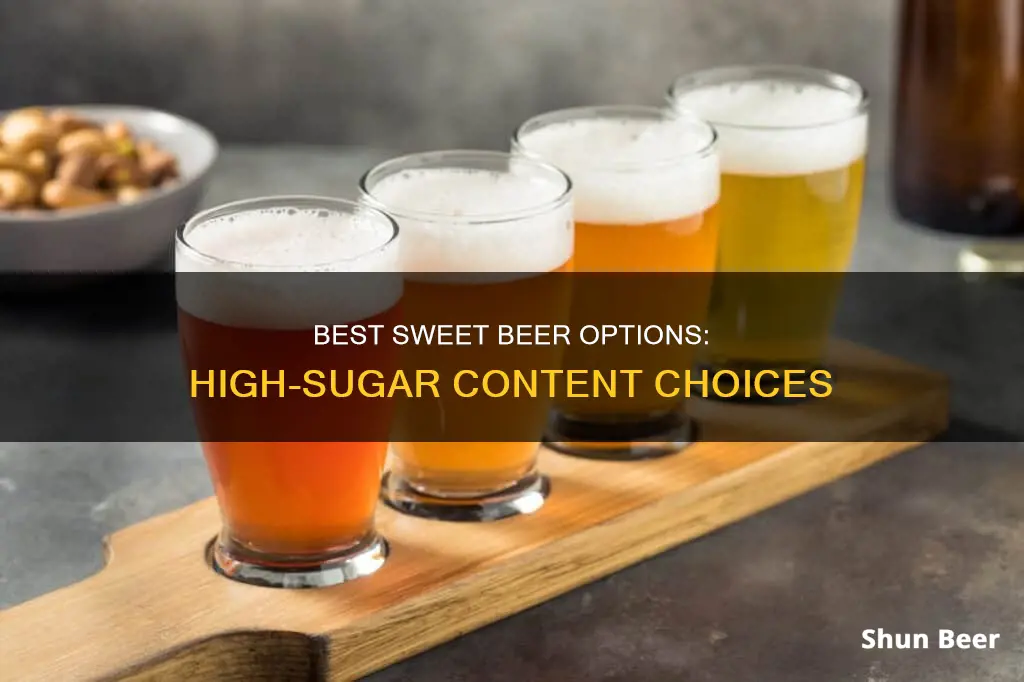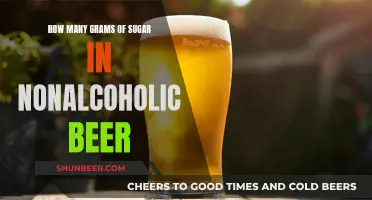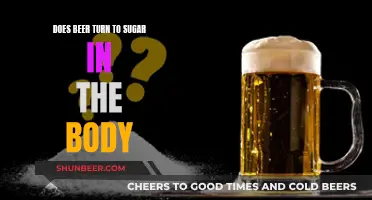
Beer is a popular alcoholic drink, but how much sugar does it contain? The answer may vary depending on the type and brand of beer. Generally, beer has less sugar than other alcoholic drinks like wine. However, some beers can have higher sugar content due to added ingredients like honey or corn syrup. So, which beers have the most sugar?
| Characteristics | Values |
|---|---|
| Sugar content | Up to 3 grams of sugar per pint |
| Sugar content in non-alcoholic beers | 10-15 grams of sugar per 12-ounce serving |
| Sugar content in light beers | Less than 1 gram of sugar per 12-ounce serving |
| Sugar content in regular beers | 2-6 grams of sugar per 12-ounce serving |
| Types of sugar in beer | Maltose, glucose, fructose |
| Impact of sugar | Weight gain, Type 2 diabetes, Heart disease, Tooth decay, Fatty liver, Affects mental health |
What You'll Learn

How much sugar is in beer?
The amount of sugar in beer varies depending on the type, brand, and brewing method. Generally, beer has less sugar than other alcoholic drinks like wine. However, some beers can have a higher sugar content due to added ingredients, such as honey or corn syrup.
Sugar is created during the brewing process, where starches in the grains are broken down into simple, fermentable sugars. The most common sugar in beer is maltose, which is made from two glucose molecules. The sweet, malty liquid produced during this process is called wort, which yeast then feeds on to produce alcohol and carbon dioxide, resulting in the creation of beer.
Types of sugar in beer
While maltose is the most prominent sugar in beer, other sugars such as glucose and fructose can also be present, especially in beers that add fruit during the brewing process.
Sugar content in different types of beer
The sugar content in beer can vary depending on the specific type and style. For example, lagers and pilsners tend to contain less sugar, while heavier, malty beers like stouts might have higher sugar levels. Here are the sugar contents of some popular beer brands (per 12 fl oz/355 ml):
- Regular beer: 12.8 grams of carbs, 0 grams of sugar
- Light beer: 5.9 grams of carbs, 0.3 grams of sugar
- Low-carb beer: 2.6 grams of carbs, 0 grams of sugar
- Non-alcoholic beer: 28.5 grams of carbs, 28.5 grams of sugar
- Miller High Life: 12.2 grams of carbs, 0 grams of sugar
- Miller Lite: 3.2 grams of carbs, 0 grams of sugar
- Coors Banquet: 11.7 grams of carbs, 0 grams of sugar
- Coors Light: 5 grams of carbs, 1 gram of sugar
- Coors Non-alcoholic: 12.2 grams of carbs, 8 grams of sugar
- Heineken: 11.4 grams of carbs, 0 grams of sugar
- Budweiser: 10.6 grams of carbs, 0 grams of sugar
- Bud Light: 4.6 grams of carbs, 0 grams of sugar
- Busch: 6.9 grams of carbs, no sugar reported
- Busch Light: 3.2 grams of carbs, no sugar reported
Beer gravity and sugar content
Beer gravity refers to the density of the wort relative to water at various stages of fermentation, and it is mostly determined by sugar content. Beers with high gravity worts tend to have more sugar, resulting in higher sugar levels post-fermentation. On the other hand, low-gravity beers typically have less sugar and lower alcohol content.
When compared to other alcoholic drinks, beer generally has a lower sugar content. For example, a single cocktail can easily contain over 30 grams of sugar due to mixers, syrups, and fruit juices. Wine also varies in sugar content, with dry wines containing 1-2 grams per serving and sweet wines containing up to 8 grams.
Low-sugar and sugar-free beer options
There are reduced sugar and low-carb beer options available, such as non-alcoholic, low-carb, and light beer varieties. These beers typically have lower sugar and carbohydrate levels, making them suitable for individuals watching their sugar intake.
Sugar Secrets: Miller Lite Beer's Sweet Truth
You may want to see also

Why is there sugar in beer?
Beer is generally made from yeast, grains, spices, and water. Sugar is not added to the ingredient list, but it is created naturally when the grains are processed and fermented by yeast. The sugar in beer is created by something called beer gravity, which refers to the density of the liquid extracted from the mashing process during the brewing of beer, known as the wort. When the wort has a lot of sugar, it's called a high-gravity wort.
The brewing process consists of malting, mashing, boiling, fermentation, and maturation. During malting, grains are soaked, germinated, and dried to convert starches into fermentable sugars. In the mashing stage, the malted grains are soaked in hot water to create the sugar-containing liquid called wort. The hops and spices are added during the boiling stage, and the wort is then cooled and filtrated.
Yeast is added to the wort during fermentation to convert sugars into alcohol and carbon dioxide. Sugar is essential to the beer-brewing process, but it is not added as an ingredient. Instead, it comes from the germination of the grains. The yeast ferments the wort, decreasing its sugar content and increasing its alcohol content, which lowers its gravity and results in a beer with a higher alcohol content.
The final sugar content of beer depends on several factors, including its gravity, type of yeast, and any additional flavours such as honey or corn syrup. While beer manufacturers are not required to report the sugar content of their products, light beers tend to have slightly higher sugar content than regular beers due to differences in their fermentation process. Non-alcoholic beers have the highest sugar content as none of the wort's sugar is converted into alcohol.
Sugar Secrets: Priming Beer with Precise Sugar Grams
You may want to see also

Beer with the highest sugar content
Beer generally contains very little sugar, and the amount varies depending on the type and brand. The sugar in beer is created during fermentation, where sugars from malted grains are converted into alcohol. Some beers may also add sugars to enhance the taste or increase the alcohol content.
The sugar content in beer is influenced by several factors, including the type of yeast, the gravity of the beer, and any additional flavours included, such as honey or corn syrup. However, it is not mandatory to label the sugar content on beer, so determining the exact amount can be challenging.
Non-alcoholic beers tend to have the highest sugar content among all types of beers. This is because the sugar in these beers is not converted into alcohol during fermentation. Regular beers typically have low residual sugar levels, often less than 1 gram per serving, while light beers usually have even less sugar.
When it comes to specific brands, here are some examples of beers with higher sugar content:
- Samuel Adams Boston Lager: 5 grams of sugar
- Guinness Draught: 3 grams of sugar
- Heineken: 5 grams of sugar
- Sierra Nevada Pale Ale: 3 grams of sugar
- Belgian Ale: up to 8 grams of sugar
- Sweet Stouts: higher sugar content
- Fruit Beers: higher sugar content
In summary, while beer does contain sugar, the amount varies and is generally low. The highest sugar content is usually found in non-alcoholic beers, followed by regular and light beers. Additionally, certain types of beer, such as sweet stouts and fruit beers, tend to have higher sugar content.
Preparing Priming Sugar: 3-Gallon Beer Guide
You may want to see also

Beer with the lowest sugar content
Beer generally has a low sugar content, and the amount of sugar in beer varies depending on the type and brand. The sugar in beer is created during fermentation, where yeast converts sugars from malted grains, mainly barley, into alcohol. The amount of sugar left in the beer depends on the type of yeast and the initial sugar content, or gravity, of the wort.
Some beer styles that typically have lower sugar content include:
- India Pale Ale (IPA): IPAs usually have less than 1 gram of residual sugar per 12-ounce serving due to the fermentation process, which converts most sugars into alcohol.
- Light Beers: Light beers are designed to be lower in calories and sugar. They often use adjuncts like rice and corn, resulting in fewer residual sugars after fermentation.
- Low-Carb Beers: Beers in this category have reduced sugar and carbohydrate content, making them suitable for those watching their sugar intake. Examples include Michelob Ultra, Corona Premier, and Budweiser Select 55.
- Pilsners: Pilsners tend to be light and crisp with less than 2 grams of sugar per serving.
- Lagers: Lagers are crisp and golden, typically containing about 2 grams of sugar.
When it comes to specific brands, here are some options with lower sugar content:
- Bud Light: 1.9 grams of sugar per can.
- Coors Light: Less than 1 gram of sugar per can.
- Miller Lite: 1 gram of sugar per can.
- Heineken: 5 grams of sugar per can.
- Guinness Draught: 3 grams of sugar per can.
- Corona Extra: 2 grams of sugar per can.
- Miller High Life: 0 grams of sugar per can.
- Budweiser: 0 grams of sugar per can.
It is important to note that non-alcoholic beers tend to have higher sugar content since the sugars are not converted into alcohol during fermentation. Therefore, if you are looking for beers with the lowest sugar content, it is best to choose from the alcoholic options mentioned above.
Whiskey or Beer: Which Drink Has a Sweeter Secret?
You may want to see also

How does sugar content vary between beer types?
The sugar content in beer varies depending on the type and brand of beer. Beer is made from yeast, grains, spices, and water. While sugar is not added to the ingredient list, it is created naturally when grains are processed and fermented by yeast. The amount of sugar in beer depends on several factors, including its gravity, type of yeast, and any additional flavours such as honey or corn syrup.
Regular beers typically have a more balanced malt and hop combination, resulting in a smoother and less bitter taste. The fermentation process for regular beers often leaves behind a moderate amount of residual sugar, usually around 2-6 grams per 12-ounce serving.
Light beers are designed to be lower in calories and sugar. Brewers often use adjuncts like rice and corn, which add fermentable sugars but result in fewer residual sugars after fermentation. Light beers typically have very low sugar content, often less than 1 gram per 12-ounce serving.
Non-alcoholic beers generally have higher sugar content because they undergo minimal fermentation. Since fermentation is what usually reduces sugar levels by converting them to alcohol, non-alcoholic beers can contain upwards of 10-15 grams of sugar per 12-ounce serving.
IPAs have low residual sugar levels due to the fermentation process, where yeast converts most of the sugars into alcohol. Compared to regular and light beers, IPAs typically have less than 1 gram of residual sugar per 12-ounce serving.
Darker beers often have a richer malt profile, which involves the use of more heavily roasted grains. These grains contribute to the beer's deeper colour, robust flavour, and higher residual sugar content.
In summary, the sugar content of beer varies depending on the type and brand. Factors such as the gravity of the beer, the type of yeast used, and any additional flavours can all influence the final sugar content. Regular beers tend to have higher sugar content than light beers, while non-alcoholic beers have the highest sugar content due to minimal fermentation. Within each category, there can also be variations depending on the specific ingredients and brewing methods used.
Guinness Beer: Sugar Content and Nutritional Facts
You may want to see also
Frequently asked questions
Sugar is created when grains are processed and fermented by yeast. The amount of sugar in beer depends on several factors, including the type of yeast and the beer's gravity, or the density of the liquid extracted from the mashing process.
The amount of sugar in beer varies depending on the type and brand. Generally, beer has less sugar than other alcoholic drinks, but some beers may have more due to added ingredients like honey or corn syrup.
Non-alcoholic beers tend to have the highest sugar content, as the sugar is not converted into alcohol during fermentation. Darker beers also tend to have more sugar than lighter ones.
It depends on the type of beer and the quantity consumed. Some beers have higher sugar content, while others are relatively low in sugar. If you're trying to maintain balanced blood sugar levels, it's best to limit your consumption of beer and other alcoholic drinks.







